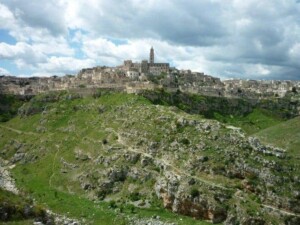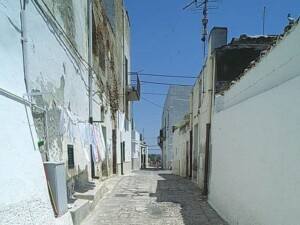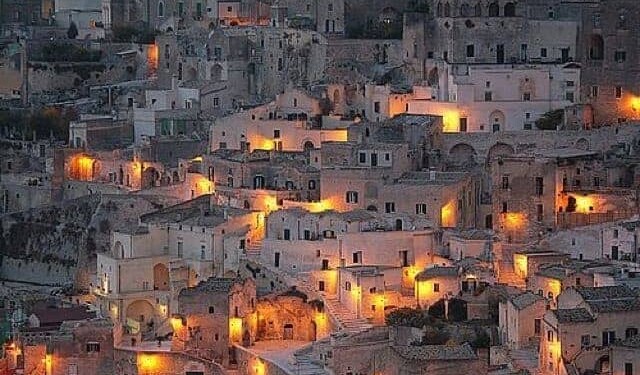Cycling from Matera Stone to the see, discovering an ancient past
Basilicata is a land reserve emotions and unexpected surprises, turn cycling lets you enjoy all its charm. Departure is from Matera a magical city, and the arrival of our itinerary is after 60 km Metaponto, location overlooking the Ionian Sea. The path is easy and mostly downhill.
MATERA IS A NATIVITY
When you arrive for the first time in Matera, you do not believe his eyes. It’s the magic of the STONES, a unique cultural landscape in the world, partly invisible, which descends towards the center of the earth, in a succession of arches that become one with the rock. Gardens and roof gardens behind the houses carved into the tufa, forming a maze of tunnels, from which comes to life one of the oldest urban settlements.
From prehistoric presence in the caves of the Paleolithic era, the entrenched villages of the Neolithic until the rock civilization with ravines and trenches carved on the steep ridges of the Murgia, from simple systems, but ingenious of water canals, until the civitas Svevo-Norman with its fortifications and subsequent massive transformations of the fifteenth and seventeenth centuries, until the effect of the urban farmer fetched survived until the fifties. A Matera you come across a story incredible and impressive, emblematic and admirable example of the extreme adaptability and perfect harmony between man and environment.
Property, trapped in the bare stone, the Sassi reserve the eyes continuously wonder and surprise. The oldest city in the world is a journey through the history of the earth A view of Italy can arouse strong emotions. First site of the South entered in the UNESCO World Heritage Site, the “capital” of history and culture that has allowed the city to apply in full as European Capital of Culture for 2019.
Biking the maze of narrow streets we go out to venture into the Rock Churches Park.
FROM MURGIA PARK TO MONTESCAGLIOSO

Many of these facilities are complemented with iazzi, livestock enclosures cave housed in caves with stone walls that enclose the outdoor space to house cattle and sheep, always made sloping to evacuate the sewage into the compost heap and facing south, to protect the animals from cold north winds. Other forms of shelter for animals are caprili rock, the complex of caves along the ravines in inaccessible places but particularly suited to host the goat breeds.
One of the most important features of the Murgia is the presence of over a hundred stone churches scattered throughout the t
After about twenty kilometers total you get near Montescaglioso a charming village that originally was a Byzantine stronghold, only to see a succession of different feudal families. Montescaglioso had its initial development around the abbey of St. Michael the Archangel (1079) full of beautiful frescoes.
Interesting is the mother church of the fifteenth century. dedicated to SS. Peter and Paul in which are preserved numerous paintings of the Venetian school.
Worthy of note are the church of Santo Stefano portal with pre-Renaissance and the Church of Our Lady of Grace in the Romanesque style.
After a bit ‘of kilometers snaking down between rolling hills, you arrive on the left of the river that runs along Bradano for quite a while’ (10km). Here are the olive groves and cultivated fields to accompany our bike ride.
FROM BERNALDA TO THE SEA

After a few kilometers we reach Bernalda. The town takes its name from that of the feudal lord, Bernardino de Bernardo, secretary of the Aragonese court, who rebuilt the castle, the home of his family.

Next to the castle is visible the mother church of San Bernardino, with red brick exterior and Byzantine domes.
But to amaze us even before we get to the sea is the archaeological area of Metaponto and in particular the National Museum of Metaponto that preserves the rich heritage of archaeological finds unearthed in the Greek colony of Metaponto. Inside the museum are reconstructed the various phases: the first prehistoric events, the arrival of the Greeks in the fifth century BC, the formation of the colony of Metaponto between the rivers Bradano and Basento, the romanization. The halls are exhibited artifacts of local culture and fine vessels italomicenei turned and decorated.
Many of these materials were processed on site by craftsmen who emigrated to the West. One section is devoted to weapons, personal ornaments, many of them in bronze, both male and female; the latter are particularly valuable.
Da qui si può prendere un treno e dirigersi alla scoperta di altri tratti della Basilicata oppure in Calabria o in Puglia.
Per informazioni www.aptbasilicata.it
Ludovica Casellati





